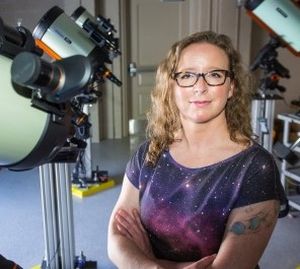Exometeorology: Determining atmospheric ..., Dr. K. Allers
Room: 100
Department of Physics and Astronomy
PHYSICS & ASTRONOMY COLLOQUIUM
Dr. Katelyn Allers
Department of Physics & Astronomy
Bucknell University
“Exometeorology: Determining the atmospheric conditions on alien worlds”
ABSTRACT
Within our solar system, we can directly observe the effects of rapid rotation on the atmospheric physics of the giant planets. Zonal winds, a result of rapid rotation and convection, play an important role in the bulk atmospheric flow. This, in turn, can impact atmospheric chemistry, as evidenced by Jupiter’s disequilibrium PH3, which dominates its mid-IR spectrum. Similar to Jupiter and Saturn, recent studies reveal that many brown dwarfs and directly-imaged exoplanets are also fast rotators with evolving atmospheric inhomogeneities. In this talk, I will discuss how we learn about the atmospheres of brown dwarfs and extrasolar planets and the importance of exoplanet analogs (from both inside and outside our solar system) for understanding the weather on exoworlds. I will discuss the predictions of recent atmospheric and dynamical models of brown dwarf and exoplanet atmospheres and what we have learned from photometric variability, spectroscopic, and radio observations. In addition, I will present a new method to measure wind speeds in cool, gas giant atmospheres. Utilizing a combination of radio observations and infrared photometric variability, we have recently placed the first observational constraints on wind speed for a cool, cloudless brown dwarf.

